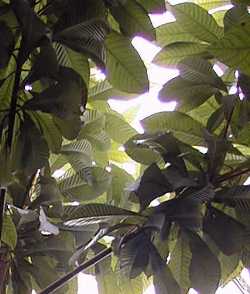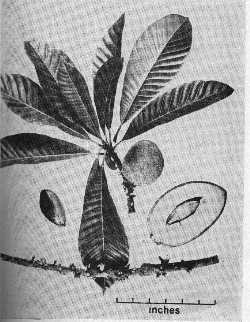Mamey Sapote
Scientific Name: Pouteria sapota (Jacq.) H.E. Moore & Stearn
Synonym: Calocarpum sapota, Lucuma mammosa
Family: Sapotaceae
USDA: 10b-12
Frost Tolerance: Damaged at 32°F (0°C), killed at 28°F (-2°C)
Sun Exposure: Light shade to full sun
Origin: Central America
Growth Habits: Evergreen tree, up to 100 feet tall (30 m)
Watering Needs: Abundant water
Propagation: Seeds

The Sapote, a native of Central America, forms a large, erect tree that may neatly veined leaves are obovate and usually pointed at the tip. They measure up to 12 inches in length by 4 inches in width, and are closely crowded at the ends of the branches. The leaves are light green on the upper surface and lighter green or brownish beneath.
Blooming Habits:
The small whitish flowers are produced in great numbers along the branchlets.
Fruiting Habits:
The russet-brown ovoid or ellipsoid fruits are 3 to 6 inches long. The thick woody skin has a roughened and scurfy surface. The firm, somewhat granular flesh is red to reddish brown and has a rich, sweet flavor. The fruits usually contain one large brown seed; the other four ovules generally abort. The fruits are eaten out of hand, and the pulp can be used to make preserves or a delicious sherbet.
Culture:
The sapote grows well on heavy soils, and the plants begin bearing within 7 to 8 years from seed. It is commonly propagated by seeds, which have a short storage life. The seeds germinate more readily if the thick husk is removed before planting.
Desert-Tropicals is dedicated to provide gardening advice, gardening ideas, and information about flower of all kind for landscape and collections.We try to check carefully the identification of the plants on the illustrations as well as the other information from the page, but occasionally errors do occur. if you notice anything that needs to be changed please contact us.Thanks.
© 1998-2020 Philippe Faucon, All Rights Reserved.
